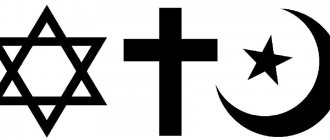Since ancient times, people have believed in supernatural forces and creatures that controlled the phenomena and processes occurring in nature. One form or another of religious belief has survived to this day in almost every corner of the globe. Currently, there are more than five thousand different forms and types of religions in the world. No one has yet been able to classify and generalize them, since all religions can be divided according to ethnicity, and according to the time of their origin, and by level of organization, and by state status.
Types of religions by time of development
So, if we divide them by level of development, we can identify the following types of typology of religion:
- Early religions are beliefs that originated in the primitive era (magic, animism, totemism, fetishism).
- Polytheistic - these include all types of national religious beliefs (except Sikhism and Judaism).
- Monotheistic - Islam, Christianity, Buddhism, Sikhism, Judaism.
- Syncretic - beliefs that arose as a result of the mixing of several types of religions.
- New religious beliefs are religions that are distinguished by their non-traditional forms. These include the churches of the Antichrist, Satan, Krishna, Moon, as well as Yogism, Shintoism with the cults of karate and judo. This also includes the White Brotherhood and various esoteric associations.
Taoism
This religion was revealed to the masses thanks to China and its founder, the sage Lao Tzu. Thanks to the philosophy that resulted in the life's work of the founder - "Tao Te Ching", religion is dedicated to 2 concepts.
The word “Tao”, which can be interpreted as a tool or method, and the letters “De”, which mean grace, prompted the thinker to deeply rethink the model of this world.
According to his thoughts, we can conclude that the Universe is controlled by an even more powerful force. The essence of its occurrence is full of secrets and mysteries, and at the same time, its influence leads existence to harmony.
The main goal of religion is to bring man closer to immortality. According to Taoist adherents, it is this that helps the individual to reveal the full power of religious contemplation of the naked beauty of the world. And breathing and gymnastic training, alchemy, hygiene of soul and body help to achieve such a state of eternal life.
Major religions of the world
The most common are:
- Christianity.
- Buddhism.
- Islam.
- Hinduism.
The largest world religion is Christianity. Currently, every country in the world has at least one Christian community, and the total number of adherents of this faith is 2.3 billion people. Christianity first appeared in the 1st century in Palestine and existed as a single form of religious belief until the Christian Church split into the Eastern Orthodox and Western Catholic churches in 1054. Later, in the 17th century, another movement of the Catholic Church appeared - Protestantism.
In addition to the main religions, there are various types of tribal religions - various forms of worship of certain deities inherent in a particular ethnic group, tribe or people.
Video about the main religions of the world:
Brahmanism
This religion also has its roots in India. It was developed thanks to Vedism. What does she teach? The most important thing is the awareness of the divine principle of everything vital and tangible, called revelations about Brahman.
And also about Atman - a unique and personal spirit. Experts in the Vedas played an invaluable role in the formation of Brahmanism as a free movement. In the religious system, the original role was assigned to them.
The main idea was based on the belief and propaganda that people are unique and it is impossible to find another identical one. That is, from childhood, a person has his own unique strength, mission and task.
Brahmanists were distinguished by complex and cult rituals. And rituals occupied the bulk of their lives and were strictly controlled.
Types of early religions
From early forms of religions the beliefs that exist today were developed. Primitive human society, in the course of its development, gradually formed various types of worship of natural phenomena: wind, thunder, rain. Due to a lack of knowledge about the processes that occur in the surrounding world, people believed that all phenomena are controlled by supernatural forces, each of which controls the weather, crops, etc. Early religions were not characterized by the identification of any one deity - people believed in symbols, invisible spirits, fetishes and various powers.
The formation of the first religious beliefs depended on the structure of society, a certain established hierarchy of groups - tribe, state, city, village or individual family.
Early religious forms are characterized by the fact that they always identified the main gods and the deities who were subordinate to them. People endowed the main gods with certain personal qualities, likening them to fathers of families, leaders or kings. The main god almost always had his own life story: birth, marriage, birth of heirs, who, as a rule, subsequently served as their assistants. In addition, the deities could be at enmity with each other, or, on the contrary, be friends, help people in agriculture, art, love and, accordingly, a certain god was responsible for each phenomenon, be it war or love.
The following types of early religions are distinguished:
- Magic.
- Fetishism.
- Totemism.
- Animism.
Magic
Magical beliefs are manifested in belief in supernatural forces, in the fact that a person is able to influence any natural phenomenon by performing certain symbolic actions - incantations, spells, etc.
This type of religion arose in ancient times and continues to exist to this day. The initial ideas about magic were quite abstract, but over time this direction of religion differentiated and today there are a huge number of its types and directions. So, depending on the methods of influence or social orientation, there are the following types of magic:
- Magic is harmful (damage).
- Therapeutic.
- Military (to attract good luck in military affairs).
- Love (lapels, love spells).
- Meteorological (for weather changes).
- Contact (magical influence by contact with an object).
- Imitative (impact on the simulated similarity of the subject).
- Partial (magical rituals using cut hair, nails or leftover food).
Fetishism
In ancient times, people revered various objects, which they believed brought good luck and protected them from dangers. This form of religious belief is called fetishism. Almost all types of primitive religion, including fetishism, exist in the modern life of many peoples. Today, people who use all kinds of talismans and amulets to attract various benefits - material or spiritual - are usually called fetishists.
Any thing or object that comes into a person’s field of vision can become a fetish: it can be stones of unusual shapes, animal skulls, wooden, metal or clay products. Such items are selected by trial and error. For example, when a person noticed that an object brought him luck, this object became his fetish, otherwise the fetishes were thrown away, destroyed and replaced with others, more fortunate.
Totemism
Primitive people believed that there was a family relationship between certain groups of people (tribe, family) and certain species of animals or plants. Thus, a tribe that considered itself related to some animal provided a special cult to it and worshiped this animal. Wind, rain, sun, iron, water, etc. were often used as totems. Such beliefs were most widespread in Africa, North America, and Australia. Totemism has survived to this day in some tribes of these countries.
Animism
Animism is also a type of early religious form. This religion is characterized by belief in spirits and souls. Ancient people believed that nature and the objects around them had supernatural powers and had a soul. Spirits were divided into evil and good. In order to appease any spirit, sacrifices were often practiced.
Animism is currently present in many modern religions. Today, spirits and evil spirits are modifications of the animistic ideas of primitive people. Although modern society considers them to be everyday superstitions and prejudices, almost all religious beliefs are associated with their existence.
Buddhism
As for Buddhism, this religious denomination is rightfully recognized as the most ancient among all that are known to the human mind. The history of this faith averages about two and a half millennia, perhaps even much more. The origin of a religious movement called Buddhism began in India, and the founder was Siddhartha Guatama. Buddha himself achieved faith gradually, step by step moving towards the miracle of enlightenment, which Buddha then began to generously share with sinners like himself. The Buddha's teachings became the basis for writing a sacred book called Tripitaka. Today, the most common stages of the Buddhist faith are considered to be Hinayama, Mahayama and Vajayama. Adherents of the faith in Buddhism believe that the main thing in a person’s life is a good state of karma, which is achieved only by doing good deeds. Every Buddhist himself goes through the path to purifying karma through hardship and pain.
Many people, especially today, wonder how many religions are there in the world? It is difficult to name the number of all directions, because new ones appear almost every day. In our article we will talk about the main ones. The following religious trend is one of them.
Types of pagan religions
The term “paganism” comes from the word “language,” which means “people” in Church Slavonic. In the era of the Old Testament, Jews called everyone who was not a Jew Gentile. This word contained a negative assessment both in relation to the peoples themselves and to their customs, religious beliefs, moral and cultural values. In Christian vocabulary, the term “paganism” appeared thanks to the Jews, but Christians do not mean by this word any connections with race or nation. There are the following types of pagan religions:
- Shamanism.
- Magic.
- Satanism.
- Materialism.
- All types of polytheistic religions.
The characteristic features that unite most of the listed religions are idolatry, magic, naturalism and mysticism.
What religion do you profess, and what religion would you like to know more about? Tell us in the comments about your attitude towards other religions.
Geography of religious movements
As for geographical fragmentation, here about 100 years ago it was possible to trace the predominance of any confession, but now there is no trace of this. For example, previously more convinced Christians lived in Africa, Europe, South America, and the Australian continent.
Residents of North Africa and the Middle East could be called Muslims, and people who settled in the territory of the South-Eastern part of Eurasia were considered believers in Buddha. On the streets of Central Asian towns, you can now more and more often see Muslim mosques and Christian churches standing almost side by side.
Historical (extinct) religions[ | ]
Main article: History of religions
- Primitive religion (English)Russian. Paleolithic religion (English)Russian.
- Atonism
- Mysteries
- Gallo-Roman religion (English)Russian.
- Mazdakism
- Norse mythology
- Druids
- Traditional beliefs of Nauru
- Selknam religion (English)Russian.
Notes[ | ]
- Doniger, 2006, p. 1148.
- ↑ 1 2 3 4 5 6 7 8 9 10 11 12 13 14 15 16 17 18 Malherbe M.
Religions of humanity = Les religions de l'Humanité / trans. from French - M.; St. Petersburg: Rudomino; University book, 1997. - 602 p. — (Myth, religion, culture). — 10,000 copies. — ISBN 5-7380-0049-8. - ↑ 1 2 3 Tattwananda S.
Vaisnava Sects, Saiva Sects, Mother Worship. — 1st revised ed. — Calcutta: Firma KLM Private, 1984. - 日蓮AC -日蓮教団系譜(undefined)
(inaccessible link). Retrieved May 21, 2011. Archived March 24, 2021. - Melton, J. Gordon (2003). Encyclopedia of American Religions
(Seventh edition). Farmington Hills, Michigan: The Gale Group, Inc., p. 991. ISBN 0-7876-6384-0
Hinduism
Hinduism is a whole system of beliefs or laws of Hindus. It differs in that it does not carry certain and established dogmas. The characteristic features or signs of the followers of Hinduism is the authoritarian recognition of Vedic teachings and, consequently, the brahmanical foundation of the worldview.
I would like to note that only those people who can boast of at least one Indian parent have the full right to profess Hinduism.
The main idea of the faith that is confessed is following certain guidelines for deliverance. Karma, as an act, and samsara, as the wheel of existence, must be overcome by an individual for complete and true liberation.
Ethnic religions[ | ]
Main article: Ethnic religion
Afroasiatic[ | ]
- Berber religion (English)Russian
- Zar (cult)
Ural[ | ]
- Mari traditional religion
- Erzya (Mordovian) religion
- Sami religion
- Udmurt religion (English)Russian.
Altai[ | ]
- Turkic-Mongolian Tengrism Aar Aiyy
- Burkhanism
- Wattisen yali
Chinese[ | ]
- Confucianism
- Taoism Folk Taoism (English)Russian.
- Yao Taoism (English)Russian
- Yiguandao
Tibeto-Burmese[ | ]
- Bon
- Batoism (English)Russian
- Benjouism (English)Russian
- Bimoism (English)Russian
- Bongtinism (English)Russian
- Burmis religion (English)Russian.
- Doni Polo
- Kiratism (English)Russian
- Sanamahism (English)Russian
- Heraka (English)Russian
- Qiang religion (English)Russian.
Korean[ | ]
- Korean shamanism
- Cheondogyo
- Jung Sando (English)Russian
Japanese[ | ]
- Shintoism
- Shugendo
- Tenrikyo
- Ryukyu religion
Thai and Miao[ | ]
- Ahom religion (English)Russian
- Thai Satsana Phi (English)Russian
- Hmongism (English)Russian
- Zhuang religion (English)Russian.
Austroasiatic[ | ]
- Vietnamese folk religion (English)Russian. Cao Dai
- Tao Mau (English)Russian
- Hoahao
Austronesian[ | ]
- Batak Parmalim (English)Russian and pemena (English)Russian
- Dayak Kaharingan (English)Russian and Momolianism (English)Russian.
- Malay folk religion (English)Russian.
- Polynesian religions Hawaiian religion
- Maori mythology
- Tagalog religion (English)Russian
African[ | ]
- Akan religion (English)Russian
- Bantu mythology (English)Russian. Zulu religion (English)Russian.
- Religion of the Congo (English)Russian.
- Ifa
- Candomblé
Indian[ | ]
- Abenaki religion (English)Russian
- Anishinaabe religion (English)Russian.
- Araucanian religion (English)Russian.
- Blackfoot religion (English)Russian.
- Guarani mythology
- Delaware religion (English)Russian
- Zuni religion (English)Russian
- Iroquoian religions (English)Russian. Huronian religion (English)Russian.
- Seneca religion (English)Russian
- Religion of the Longhouse (English)Russian.
- Miwok religion (English)Russian.
- Aztec religion
Other ethnic[ | ]
- Australian Aboriginal religion
- Adyghe Khabze
- Papuan mythology
- Siberian shamanism
- Eskimo mythology
- Iron ægdau
Islam
I could not help but mention this world religion that originated in Arabia. Prophet Muhammad, who spoke in Mecca, is considered its founder. According to his beliefs, as well as thanks to his statements, labor was created after his death. In the future, it became the holy book of Islam and to this day bears the famous name - the Koran.
What's the point? The main teaching is: “There is no God but Allah.” But angels and other entities of the higher worlds are not free, but in complete submission to Him.
Also, Muslims are convinced that their religion is the most correct, since Muhammad is the last prophet whom God sent to Earth. The knowledge and wisdom of previous religions, in the opinion of Muslims, are not reliable due to the fact that people have repeatedly rewritten and deformed sacred knowledge.
Indian (dharmic) religions[ | ]
Religions originating in India or traditionally associated with India.
Hinduism[ | ]
Main articles: Hinduism
and
Directions of Hinduism
Vaishnavism[ | ]
Main articles: Vaishnavism
and
Krishnaism
- Brahma-sampradaya of Haridasa (English)Russian.
- Gaudiya Vaishnavism Gaudiya Saraswata Sampradaya International Society for Krishna Consciousness
- Pushtimarga
- Vadagalai Munitraya Sampradaya (English)Russian
- Manavala Mamunigal sabha
- Balmiki (English)Russian
Shaivism[ | ]
Main article: Shaivism
- Aghori
- Ganapatya
- Kapalika
- Kaumara
- Kashmir Shaivism Trika
- Kubjikamata (English)Russian
- Inchegiri-sampradaya (English)Russian
Others[ | ]
- Shrout
- Shaktism Kali-kula
- Sri Kula[3]
- Bauls
- Arya Samaj
Schools and movements of Hindu philosophy[ | ]
Main article: Philosophy of Hinduism
- Nyaya
- Vaisesika
- Vedanta (uttara-mimamsa) Advaita
- Vishishta-advaita
- Dwight
- Bhakti yoga, bhakti
Ayyavazhi[ | ]
Main article: Ayyavazhi
Buddhism[ | ]
Main article: Schools of Buddhism
- Nikaya (early schools of Buddhism) Theravada Amarapur Nikaya (English) Russian.
- Siam Nikai (English)Russian
- Ramanna-nikaya (English) Russian.
- Sangharaj Nikaya (English) Russian.
- Mahasthabir-nikaya (English) Russian.
- Thudhamma-nikaya (English) Russian.
- Shwejin-nikaya (English) Russian.
- Maha-nikaya (English) Russian. Dhammakaya (English)Russian
- Thai forest tradition (English)Russian. (kammatthana)
- Madhyamaka Prasangaka
- Nichiren-shu
- Dashabhumika (English)Russian
- Shingon
- Society of Friends of the Western Buddhist Order (English)Russian.
Jainism[ | ]
Main article: Jainism
- Digambaras
- Svetambara
Sikhism[ | ]
Main article: Sikhism
Din-i illahi [ | ]
- Din-i illahi
Confucianism
Confucianism is based on the teachings of one person - in this case, the Chinese politician, teacher and philosopher Confucius (551-479 BC). It is worth noting that he himself claimed to be part of a scientific tradition dating back to an earlier golden age.
Although Confucianism is the most humanistic and least spiritual creed on this list, it does embrace a supernatural worldview (it includes Heaven, the Lord in Heaven, and divination) influenced by Chinese folk tradition.
Since the teachings were first collected in the Analects one or two generations after the death of Confucius, the tradition has experienced various periods of popularity and unpopularity in China and is one of the leading teachings influencing modern Chinese folk religion. Strict Confucians are said to number about six million.











